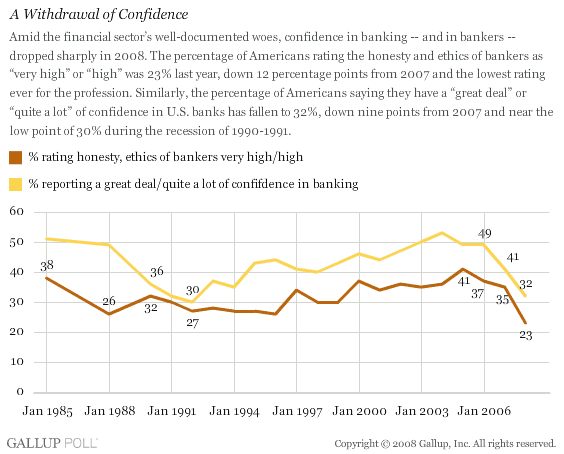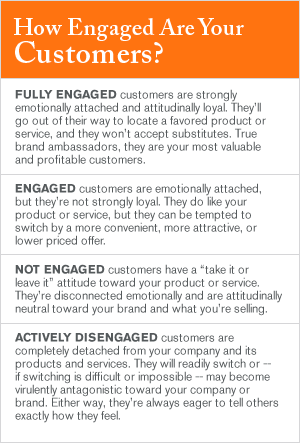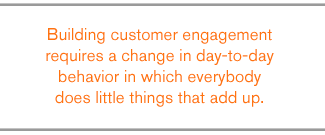The past year has been brutal for the banking industry. Amid its well-documented woes, many self-created, the image of the industry -- and of bankers themselves -- was bound to take a hit.
So it's no surprise that the ranking for bankers slumped in Gallup's annual survey of honesty and ethics in the professions. The percentage of Americans rating the honesty and ethics of bankers as "very high" or "high" was 23% in 2008, down 12 percentage points from the 2007 ranking and the lowest rating ever for the profession. The last time bankers' image plunged like this was 1988, when their positive rating fell from 38% to 26% during the savings and loan scandal. (See graphic "A Withdrawal of Confidence" below and "Nurses Shine, Bankers Slump in Ethics Ratings" in the "See Also" area on this page.)

The public is clearly reacting to recent economic news. Plummeting stock prices, a shrinking economy, rising jobless rates, the consumer credit crunch, and rising foreclosure rates have shaken their faith in the economy in general -- and in banking and bankers in particular. Maybe that's fair, and maybe it isn't. But "feelings are facts," and the upshot is that bank customers don't trust bankers as much as they used to. In our emotional economy, that lack of trust is bound to have a negative effect on banking relationships, starting with basic customer satisfaction.
Satisfaction isn't engagement
As John H. Fleming, Ph.D., and Jim Asplund note in Human Sigma, a growing number of case studies indicate that there are two types of customers who are extremely satisfied, or who give the highest rating of overall satisfaction with a company's products or services: those who are rationally satisfied and those who are emotionally satisfied. Rationally satisfied customers are extremely satisfied with a company, but they lack a strong emotional connection with its products or services. In fact, they behave little differently from dissatisfied customers. Emotionally satisfied customers, in contrast, are extremely satisfied with the company, but they also feel a strong emotional attachment to its products or services. They deliver more value to a company by buying more products, spending more for them, returning more often, or staying longer with the business.
The ability to rationally satisfy customers is a baseline expectation, much like providing accurate statements delivered on time or the ability to comply with bank regulations. A bank that can't satisfy customers on a rational level is a bank that's in dire trouble. Most banks and bankers are more than capable of creating baseline levels of customer satisfaction -- but it doesn't matter as much as they might think.
Rational satisfaction alone isn't enough to generate the emotional attachment that ultimately will make customers more valuable to the business, especially during times of low public opinion. Customer satisfaction doesn't do much for banks even during good economic times because satisfied customers still defect to the competition. Many studies suggest that high levels of satisfaction don't pay off in better performance on key economic indicators. As strange as it seems, dissatisfied customers are often a little more likely than rationally satisfied ones to be loyal to a company they don't like. Focusing solely on satisfying customers in the current stormy financial climate is a losing proposition.
This is what I recommend instead: Focus on engaging customers, especially during rough times like these. Fully engaged customers are not only loyal, but they also feel a strong emotional attachment to your company and its products and services. Fully engaged customers will trust you. They'll support you financially. And they will help your bank grow.
The reason these customers are so valuable to banks is that customer engagement is indelibly tied to financial performance. Based on analysis of Gallup's extensive database containing thousands of customer engagement ratings, fully engaged customers represent a 23% premium in terms of share of wallet, profitability, revenue, and relationship growth, while actively disengaged customers represent a 13% discount. (See graphic "How Engaged Are Your Customers.")

I don't know of a bank that doesn't want to increase its deposit account balances, and customer engagement may be the most profound key lever banks can pull to deliver this growth. But unlike customer satisfaction, customer engagement isn't the result of competent business practices -- it's the result of an emotional investment that the customer makes in your bank.
Building engagement
Customer engagement is a form of psychological attachment, one in which a customer becomes so passionately bonded to a company that he or she won't go anywhere else. Engaged customers are much more loyal, they lobby friends on their favorite banks' behalf, and if there's a minor problem or service hiccup, engaged customers are much more likely to forgive the business.
This attachment isn't easily built; several requirements must be met before a customer can become engaged. The first is rational satisfaction, which is a baseline expectation for any business and must be accomplished first. It doesn't spur outsized financial performance, but it is essential.
Once this baseline is established, banks can begin the real work of engaging customers emotionally. The first and foundational dimension of emotional attachment is Confidence, a sense that the customer can trust the bank and that it will do what it says it will. Then the customer must believe that the bank has Integrity -- that it will treat customers fairly and resolve problems equitably.
Next, customers need to feel a sense of Pride in doing business with that bank -- and if you don't think people can consider their banks status symbols, bear in mind that Gallup's customer engagement database includes people who are deeply engaged with and very proud of all sorts of products, including their laundry detergent. Finally, highly engaged customers will feel a sense of Passion about their bank. These customers believe that the bank is perfect for people like them -- so much so that they can't imagine a world without it.
Take note of the first two steps on the engagement pyramid: Confidence and Integrity. The ability to trust in the bank's acumen and honesty is the foundation of customer engagement. It is highly unlikely that banks can successfully move from satisfaction to engagement with a base that is on shaky ground. That's why bankers should be nervous when only 23% of Americans rate their honesty and ethics "very high" or "high," while 53% consider them "average," and nearly a quarter of Americans (23%) are troubled enough to rate bankers' honesty and ethics "low" or "very low."
Small change
I know that many bankers are asking themselves if customer engagement is worth bothering with right now when simply getting through the day is hard enough. They hope or assume that public opinion will change or that inertia will keep even the most disenchanted customers around. I understand the bankers who use that line of reasoning. But it's based on faulty -- and worse, risky -- assumptions.
First, building customer engagement does take deliberation and precious resources, but it's not an initiative or a one-shot program. It's a change in day-to-day behavior in which everybody does little things that add up. It would take a lot of energy to launch a full-out assault on customer disengagement -- energy that most banks don't have right now. But while you can't affect the opinion of every consumer, you can influence the opinions of the customers who interact with your bank every day. The alternative leaves your business vulnerable to macroeconomic forces that are out of your control or to competitors who are working on customer engagement.

And it doesn't take much to make changes that build customer engagement. Simple transparency and customer advocacy is a good place to start. For example, remind the person selling CDs to make sure customers know the financial penalty for early withdrawal so that if they do need to take money out early, they aren't caught by surprise by the charges. Explain to your mortgage customers about rate changes, fees, or other charges to show that you put their financial interests ahead of your own. Consult with the small business owner who asks for a few more days to make a payment to ensure her business is on sound footing; this will demonstrate that her business' well-being is important to you too. All those things create customer confidence and a sense of integrity -- and they don't cost a dime or require a staff meeting.
Bad rep
As for public opinion, it can certainly change -- but it will take time and a great deal of effort to restore trust. As the graph on page 1 shows, it took about 15 years for confidence levels to return to where they were before the savings and loan crisis. I'm a 20-year banking veteran, and believe me, knowing that Americans are troubled about the honesty and ethics of bankers hurts.
Banks and bankers are, by and large, genuinely ethical people who take the best interests of their customers to heart. The industry's confidence and honesty and ethics ratings hint at just how hard it will be to fully restore public trust. Money is personal. Customers entrust their stability and their security to banks. People feel that trust has been violated when they believe bankers aren't adequately protective of their money. And even if your bank is working hard to serve its customers, they may still be wary and feel the need to watch their backs.
Despite this low point -- or maybe because of it -- this is an excellent time to make sure your customers know you're bending over backward to serve them while securely protecting their assets. One of the best ways to do this is by focusing on local customer interactions.
Over the years, Gallup has found that when it comes to trust, proximity counts. For instance, while the majority of Americans may have a low opinion of Congress, they generally have a fairly high opinion of the congressperson who serves their district. The same principle applies to their perception of how things are going in the country generally. Americans' satisfaction levels tend to rise as they rate conditions in the United States versus their own state and in their local community. (See "Americans' Satisfaction: There's No Place Like Home" in the "See Also" area on this page.)
So emphasize your bank's deep commitment to and involvement in the community. Explain that your products and services are an integral and reliable part of the day-to-day lives and businesses of people they know. Celebrate that you've been trustworthy for years and that nothing has changed -- and it never will.
Don't rest on your laurels
The worst of all assumptions is that customers are loyal. It's not true. Only fully engaged customers are reliably loyal because of their emotional attachment to your company. Inertia may keep people around, but in tough financial times, actively disengaged customers will leave for a bank they believe offers a better rate or a better banking story. Or they'll leave because they're worried about their security, and fear trumps laziness.
There's always a bank offering what looks like a better rate on something. Your customers see those ads every day. You will lose customers to those appeals if you haven't engaged them emotionally. Make your appeal personal, take every opportunity to prove you mean it, and look for ways to reinforce the message.
This is a tough time for banks. Many in the financial services sector are wondering how they're going to make it through. The industry is stressed and troubled. But even in these dire circumstances, making the effort to engage customers is a bank's best option. When the public doesn't trust you or your industry, you need to demonstrate your integrity. When the public questions whether you're there for them, you need to give them confidence in your services and make them proud to be your banking customer.
Do all these things effectively, and you'll keep the fully engaged customers you've got. And what's more, they'll do more business with you. That's reason enough -- but here's a more compelling one: Lots of your competitors won't bother. They're letting macroeconomic forces drive them, and they're assuming that their customers are caught by inertia to leave. Prove that you're different, and those customers are yours. And in tough financial times, those are customers your bank needs.

